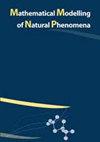MODELLING OF HILLSLOPE STORAGE UNDER TEMPORALLY VARIED RAINFALL RECHARGE
IF 2.1
4区 数学
Q2 MATHEMATICAL & COMPUTATIONAL BIOLOGY
引用次数: 1
Abstract
Water storage inside hillslopes is a crucial issue of environment and water resources. This study separately built a numerical model and an analytical model employing a hillslope-storage equation to simulate the water storage in a sloping aquifer response to recharge. The variable width of hillslope was hypothetically represented by an exponential function to categorize the hillslope into three types: uniform, convergent, and divergent. An integral transform technique was introduced to derive the analytical solution whereas a finite difference method was employed for the numerical modelling. As a result, under the same scenario a gap existed between the two solutions to distinct forms of the water storage equation, and the gap decreases with a falling recharge rate for convergent hillslopes. Moreover, all outflows gradually approached one value based on different hillslopes under the same accumulative recharge amount for six typical rainfall recharge patterns. Particularly, while the recharge stops, the outflow decreases and then mildly rises for a long time for convergent hillslope because of the slow water release near the upstream boundary where the storage water is relatively abundant due to the widest width.降雨补给随时间变化的山坡蓄水模型
山坡内的蓄水是一个至关重要的环境和水资源问题。本研究分别建立了一个数值模型和一个分析模型,采用山坡蓄水方程来模拟斜坡含水层的蓄水对补给的响应。假设山坡的可变宽度由指数函数表示,将山坡分为三种类型:均匀型、收敛型和发散型。引入积分变换技术来导出解析解,而采用有限差分方法进行数值建模。因此,在相同的情况下,不同形式的蓄水方程的两个解之间存在差距,并且随着收敛山坡的补给率下降,差距减小。此外,对于六种典型的降雨补给模式,在相同的累积补给量下,基于不同的山坡,所有外流逐渐接近一个值。特别是,当补给停止时,收敛山坡的流出量减少,然后在很长一段时间内缓慢上升,因为上游边界附近的水释放缓慢,而上游边界由于宽度最宽而蓄水相对丰富。
本文章由计算机程序翻译,如有差异,请以英文原文为准。
求助全文
约1分钟内获得全文
求助全文
来源期刊

Mathematical Modelling of Natural Phenomena
MATHEMATICAL & COMPUTATIONAL BIOLOGY-MATHEMATICS, INTERDISCIPLINARY APPLICATIONS
CiteScore
5.20
自引率
0.00%
发文量
46
审稿时长
6-12 weeks
期刊介绍:
The Mathematical Modelling of Natural Phenomena (MMNP) is an international research journal, which publishes top-level original and review papers, short communications and proceedings on mathematical modelling in biology, medicine, chemistry, physics, and other areas. The scope of the journal is devoted to mathematical modelling with sufficiently advanced model, and the works studying mainly the existence and stability of stationary points of ODE systems are not considered. The scope of the journal also includes applied mathematics and mathematical analysis in the context of its applications to the real world problems. The journal is essentially functioning on the basis of topical issues representing active areas of research. Each topical issue has its own editorial board. The authors are invited to submit papers to the announced issues or to suggest new issues.
Journal publishes research articles and reviews within the whole field of mathematical modelling, and it will continue to provide information on the latest trends and developments in this ever-expanding subject.
 求助内容:
求助内容: 应助结果提醒方式:
应助结果提醒方式:


